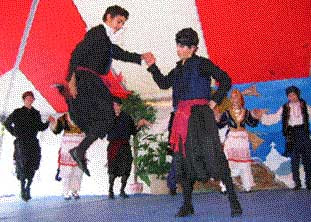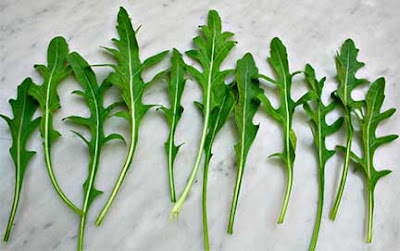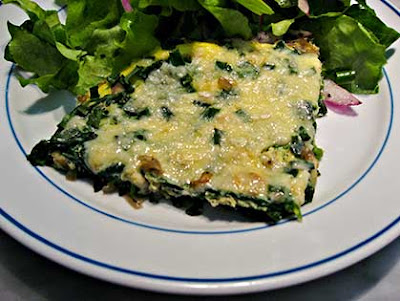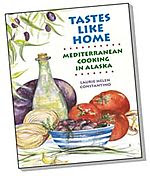Happy New Year to one and all!
I’m back from recent travels and recovered from holidays full of family, parties, and baking. You heard it here first: I’m never eating cookies or candy again. Ever. Or at least until memories of the last month fade into nothingness.
It’s hard to decide what to write about because I have a giant backlog of recipes and photographs. So instead of actually making a decision, I jumbled my stack of notes, and randomly drew out the recipe for Leek Mousaka.
When we arrive in Greece from Alaska, the first thing we do is go to an airport newsstand for newspapers and at least one cooking magazine. Properly armed, we head for our hotel to read and relax from the long trip.
Lately, my favorite Greek magazine is Olive (a spin-off of BBC Olive). Sprightly Greek food personality Ilias Mamalakis first drew me to Olive, but I continue reading it for updates on the Greek food world and interesting recipes. Sadly, Olive isn’t available in Alaska, even by subscription. As a leek lover and someone with a healthy supply of homemade Greek egg noodles (hilopites), Olive’s recipe for Leek Mousaka was intriguing. Out of curiosity, I googled “Μουσακάς + Πράσα” (Mousaka + Leeks) to see if Olive’s recipe was unique. A number of websites had identical Leek Mousaka recipes, but only one credited the magazine. None credited Georgia Kofinas (Γεωργία Κοφινάς), who Olive identifies as the recipe’s creator.
As a leek lover and someone with a healthy supply of homemade Greek egg noodles (hilopites), Olive’s recipe for Leek Mousaka was intriguing. Out of curiosity, I googled “Μουσακάς + Πράσα” (Mousaka + Leeks) to see if Olive’s recipe was unique. A number of websites had identical Leek Mousaka recipes, but only one credited the magazine. None credited Georgia Kofinas (Γεωργία Κοφινάς), who Olive identifies as the recipe’s creator.
There’s no way for me to know whether the recipe actually originated with Kofinas or someone else. However, the issue of copying recipes without attribution is one that, sooner or later, all food writers must confront. It’s infuriating when others appropriate recipes without permission or attribution. On the other hand, it’s easy to give credit to those whose work contributed to your creation.
Here's my practice and, if I could wave a magic wand, it’s one all food bloggers and writers would follow:
1. If I use a recipe exactly as written (which I rarely do), under the name of the recipe I write “recipe by” and identify the author and source of the recipe. My article about the recipe also includes a review of the source book, magazine, or blog and applicable permalinks.
2. If I make only minor changes to a recipe, under the name of the recipe I write “recipe adapted from” and identify the author and source of the original recipe.
3. If I make major changes to someone else’s recipe, under the name of the recipe I write “recipe inspired by” and identify the author and source of the inspirational recipe.
4. If I don’t designate “recipe by,” “recipe adapted from,” or “recipe inspired by,” the recipe is my creation.
Of course, there are simple dishes that many cooks discover or invent on their own, without ever having seen a similar recipe. Oven-roasted vegetables, vinaigrettes, risottos, soups, and eggs are only a few examples of such recipes. Any similarities in recipes like this are, more likely than not, coincidental.
In the case of Leek Mousaka, I significantly changed the original recipe. I cooked the leeks without water to boost their flavor, used a personal recipe for tomato-meat sauce, enhanced the topping with cream and cheese, and adapted the recipe so it can be made with ingredients available in the United States. Even though I made major changes to the original recipe, I wouldn’t’ve made it without Olive’s inspiration, so included a credit for both the magazine and the recipe’s creator.
Leek Mousaka is quite different from the typical Mousaka found in Greek restaurants around the world, and is wonderfully delicious. The sweetness of sautéed leeks enhances the minty tomato-meat sauce and contrasts with the tart yogurt. Noodles play harmony to Leek Mousaka’s aromatic flavors, and form a pleasurably crispy top crust. The resulting dish is attractive, delectable, and suitable for any occasion.
 Leek Mousaka (Μουσακάς με Πράσα)
Leek Mousaka (Μουσακάς με Πράσα)Serves 6 – 9
Inspired by Μουσακάς με Πράσα, <<Φθινοπωρινή συμφωνία>> by Γεωργία Κοφινάς in BBC Olive (Greek version), Issue 19, October 2008
Leek Mousaka can be made for vegetarians by using my recipe for Tomato Sauce with Celery and Mint (and simmering it until it’s thick) instead of the meat sauce described below. Although Leek Mousaka has many steps, it goes together quickly once the component parts are done. The meat sauce may be made days ahead (or months ahead if you freeze it). The yogurt may also be made well ahead (or purchased, if strained Greek yogurt is available where you live). Because I prefer strained yogurt for all purposes, I usually strain yogurt right after I bring it home from the market so it’s ready when I want it. Leeks can hold dirt between their layers, so must be carefully cleaned. After removing the dark green portions and the root ends (both of which can be saved for vegetable stock), cut the leeks in half. Under running water, rinse out any dirt trapped between the leeks’ layers, using your fingers to help remove any stubborn clumps of dirt. Every layer of Leek Mousaka is separately salted (doing so brings out the full flavor of each ingredient), so be careful not to over-salt any one layer or the finished dish will be too salty.
Yogurt Filling:
2 cups plain yogurt, preferably whole-milk (or 1 1/4 cup strained yogurt, see Note above)
2 medium-sized garlic cloves
1/4 tsp. salt
Meat and Tomato Sauce with Celery and Mint:
1 pound ground beef
Salt
Freshly ground black pepper
2 cups diced onions, 1/4” dice
1 cup diced celery, 1/4” dice (2 – 3 stalks)
1 Tbsp. minced garlic
1 tsp. Aleppo pepper or 1/2 tsp. crushed red pepper
1 14.5-ounce can, or 2 cups fresh, crushed tomatoes
3/4 cup dry white wine
1/4 cup minced fresh mint
Noodles:
1/2 pound thin egg noodles, vermicelli, fides, broken-up angel hair pasta, or any other similarly-shaped pasta
Leeks:
8 cups diced leeks, white and light green parts only, 1/2” dice (4-5 leeks)
3 Tbsp. olive oil
Salt
Freshly ground black pepper
Topping:
2 eggs
1/2 cup heavy cream
Salt
Freshly ground black pepper
Olive oil for coating the baking pan
1 cup freshly grated kefalotyri, parmesan, or Romano cheese, divided
 Make the Yogurt Filling: Line a strainer with a paper towel and dump in the yogurt. Let the yogurt drain for at least 1 hour (straining for 2 hours is better if you have time). Purée garlic by mashing it into the salt with the flat of a knife or in a mortar and pestle. Mix the puréed garlic into the strained yogurt.
Make the Yogurt Filling: Line a strainer with a paper towel and dump in the yogurt. Let the yogurt drain for at least 1 hour (straining for 2 hours is better if you have time). Purée garlic by mashing it into the salt with the flat of a knife or in a mortar and pestle. Mix the puréed garlic into the strained yogurt.Make the Meat and Tomato Sauce with Celery and Mint: Sauté the ground meat, lightly seasoned with salt and freshly ground pepper, until it is nicely browned. Add the diced onions and celery and sauté until the onions begin to brown. Stir in the garlic and Aleppo pepper and cook for 1 minute. Stir in the crushed tomatoes and white wine and bring to a boil. Cook rapidly for five minutes, stirring constantly. Turn the heat down to medium, and simmer for 15 – 20 minutes or until most of the liquid in the sauce has evaporated. Taste and add salt and freshly ground black pepper, as needed. Stir in the mint and take the sauce off the burner.
Cook the Noodles: Add the noodles to boiling salted water and cook until they’re half done. (Because the noodles are small, they cook quickly.) Drain and set aside.
Make the Leeks: Sauté the diced leeks in olive oil, lightly seasoned with salt and freshly ground black pepper, until the leeks are soft.
Make the Topping: Whisk together the eggs, cream, a little salt, freshly ground black pepper, and 1/3 cup of grated cheese.
Assemble the Mousaka: Preheat the oven to 400°F.
Thoroughly oil a 10” x 10” baking pan. Spread half the noodles over the bottom of the pan. Evenly sprinkle 1/3 cup grated cheese over the noodles. Evenly spread the leeks over the grated cheese, the yogurt filling over the leeks, the meat sauce over the yogurt, 1/3 cup grated cheese over the meat sauce, the remaining noodles over the grated cheese, and the egg/cream topping over the noodles.
Bake for 50 to 55 minutes. Let cool for at least 10 minutes before cutting into pieces with a very sharp or serrated knife.
Serve with a crisp green salad, Kalamata olives, and crusty bread.
~~~~~~~~~~~~~~~~~~~~~~~~~~~~~
This is my entry for Weekend Herb Blogging, hosted this week by Pam from The Backyard Pizzeria.
 Limpets tightly adhere to rocks in shallow water where the sea meets the shore. They’re found throughout the Mediterranean, and on rocky coastlines
Limpets tightly adhere to rocks in shallow water where the sea meets the shore. They’re found throughout the Mediterranean, and on rocky coastlines  I recognized the limpets immediately but couldn’t fathom why two grown men would gather them. “They’re called petalides” my husband said. “Try one, they’re edible.” He pulled out two limpets the size of half-dollars and wiped algae off the undulating brown feet with a corner of his shirt.
I recognized the limpets immediately but couldn’t fathom why two grown men would gather them. “They’re called petalides” my husband said. “Try one, they’re edible.” He pulled out two limpets the size of half-dollars and wiped algae off the undulating brown feet with a corner of his shirt.  It takes good balance to gather limpets. The rocks on which they live are slippery with algae; breaking waves make the rocks even more treacherous.
It takes good balance to gather limpets. The rocks on which they live are slippery with algae; breaking waves make the rocks even more treacherous. 
 All these years later, as soon as we arrive on the island and the jetlag wears off, we head straight to the beach with a loaf of bread, some olives, and a bottle of ouzo. We gather a bag of limpets and eat our fill. The next day, we feast on Limpets Casino. Even though we now have a broiler, we use the outdoor grill to cook them from below.
All these years later, as soon as we arrive on the island and the jetlag wears off, we head straight to the beach with a loaf of bread, some olives, and a bottle of ouzo. We gather a bag of limpets and eat our fill. The next day, we feast on Limpets Casino. Even though we now have a broiler, we use the outdoor grill to cook them from below. 

 Our destination was a small church overlooking the sea. On arrival, the men changed into wading gear. Armed with a “louks” (λουξ - a bright kerosene lantern), and “kalamis” (καλάμι – a long bamboo pole split on the end and spread to form two springy fingers that can be pressed over the sea urchins’ spines to pluck them from the water), they entered the sea.
Our destination was a small church overlooking the sea. On arrival, the men changed into wading gear. Armed with a “louks” (λουξ - a bright kerosene lantern), and “kalamis” (καλάμι – a long bamboo pole split on the end and spread to form two springy fingers that can be pressed over the sea urchins’ spines to pluck them from the water), they entered the sea. We watched the bright lantern light slowly move in the shallows along the rocky fingers that reach out to sea from the church. Men’s voices and snippets of conversation rolled over the water, “be careful, a ledge here…”, ”it's slippery there...”, “that’s a big one…”, “bah, that one’s no good…”, “Wait… Wait… don’t move! An octopus… its legal! Got it.” “Bravo Kapetanio!”
We watched the bright lantern light slowly move in the shallows along the rocky fingers that reach out to sea from the church. Men’s voices and snippets of conversation rolled over the water, “be careful, a ledge here…”, ”it's slippery there...”, “that’s a big one…”, “bah, that one’s no good…”, “Wait… Wait… don’t move! An octopus… its legal! Got it.” “Bravo Kapetanio!” Opening Sea Urchins - Step 1
Opening Sea Urchins - Step 1 Opening Sea Urchins - Step 2
Opening Sea Urchins - Step 2 Opening Sea Urchins - Step 3 (Sping-gathered Urchin)
Opening Sea Urchins - Step 3 (Sping-gathered Urchin) Sea Urchin Salad (Αχινοσαλάτα) at
Sea Urchin Salad (Αχινοσαλάτα) at  One of the best ways to eat summer tomatoes is in Horiatiki Salata (Village Salad), a mix of tomatoes, cucumbers, onions, green pepper, and feta cheese, dressed only with olive oil and salt. This most beloved of Greek salads appears on taverna menus throughout the country. During tomato season in Greece, we eat a variation of Horiatiki Salata every day.
One of the best ways to eat summer tomatoes is in Horiatiki Salata (Village Salad), a mix of tomatoes, cucumbers, onions, green pepper, and feta cheese, dressed only with olive oil and salt. This most beloved of Greek salads appears on taverna menus throughout the country. During tomato season in Greece, we eat a variation of Horiatiki Salata every day. The Greek name “Strapatsada” derives from the Italian for “scrambled eggs” (“uova strapazzate”).
The Greek name “Strapatsada” derives from the Italian for “scrambled eggs” (“uova strapazzate”). 
 Sauté the onions, lightly seasoned with salt and freshly ground black pepper, in olive oil until they soften and start to turn golden. Stir in the diced tomatoes, bring to a boil, turn down the heat to medium, and cook for 15 minutes or until most of the water in the tomatoes has evaporated, stirring regularly to prevent scorching and to break up the tomatoes. Stir in the garlic and cook for 5 minutes. Taste; if the tomatoes are too acidic, add 1 teaspoon sugar.
Sauté the onions, lightly seasoned with salt and freshly ground black pepper, in olive oil until they soften and start to turn golden. Stir in the diced tomatoes, bring to a boil, turn down the heat to medium, and cook for 15 minutes or until most of the water in the tomatoes has evaporated, stirring regularly to prevent scorching and to break up the tomatoes. Stir in the garlic and cook for 5 minutes. Taste; if the tomatoes are too acidic, add 1 teaspoon sugar. Sandy beaches and rocky promontories alternate along the island’s irregular coastline. Mounds of wild thyme cover the hills sloping down to the sea, and scent the sea air with their heady aroma.
Sandy beaches and rocky promontories alternate along the island’s irregular coastline. Mounds of wild thyme cover the hills sloping down to the sea, and scent the sea air with their heady aroma. 

 Cinnamon-Honey Tart (Melopita – Μελόπιτα)
Cinnamon-Honey Tart (Melopita – Μελόπιτα) Dancers waiting to perform.
Dancers waiting to perform. Dance Group
Dance Group Antonia packaging pastries for sale (wearing our new
Antonia packaging pastries for sale (wearing our new  Baklava
Baklava
 Holy Transfiguration Greek Orthodox Church just before the 2008 Greek Festival opened. Before it was sanctified as a church, this was a personal residence. The building is much too small for our parish, and must be replaced. All the proceeds from the cookbook, the apron, and the car raffle go directly into our Building Fund. Part of the funds raised by the festival go towards church operating expenses, and the rest go into the Building Fund.
Holy Transfiguration Greek Orthodox Church just before the 2008 Greek Festival opened. Before it was sanctified as a church, this was a personal residence. The building is much too small for our parish, and must be replaced. All the proceeds from the cookbook, the apron, and the car raffle go directly into our Building Fund. Part of the funds raised by the festival go towards church operating expenses, and the rest go into the Building Fund. Raffle prize (drawing to be held just before Greek Festival closes on Sunday August 17).
Raffle prize (drawing to be held just before Greek Festival closes on Sunday August 17). John Basting Lamb on the Spit at the 2004 Greek Festival
John Basting Lamb on the Spit at the 2004 Greek Festival We’ve brought a wonderful Greek band up from California to entertain attendees with traditional Greek music. Parish dance groups will perform during the afternoon and festival attendees can join in rounds of Greek dancing.
We’ve brought a wonderful Greek band up from California to entertain attendees with traditional Greek music. Parish dance groups will perform during the afternoon and festival attendees can join in rounds of Greek dancing. Sonia, Laurie, and Salwa in the Dinner Booth at the 2004 Greek Festival
Sonia, Laurie, and Salwa in the Dinner Booth at the 2004 Greek Festival Arugula (also known as
Arugula (also known as  Most commonly I use arugula in mixed green salads, or on its own with blue cheese and best quality balsamic vinegar. This year the arugula was so prolific I branched out. Arugula, briefly
Most commonly I use arugula in mixed green salads, or on its own with blue cheese and best quality balsamic vinegar. This year the arugula was so prolific I branched out. Arugula, briefly 


 Arugula, Anchovy, and Tomato Sauce with
Arugula, Anchovy, and Tomato Sauce with 

 Without trees to obscure the view, the deep blue Aegean sky and sea are constant companions. Their brilliant blues combine with the burnished gold landscape and lazy cries of circling birds to induce an overwhelming sense of peace and calm.
Without trees to obscure the view, the deep blue Aegean sky and sea are constant companions. Their brilliant blues combine with the burnished gold landscape and lazy cries of circling birds to induce an overwhelming sense of peace and calm.
 White-washed houses, bright blue skies, sun sparkling on the sea, and brilliant sunsets. Some of Greece’s most iconic images are of
White-washed houses, bright blue skies, sun sparkling on the sea, and brilliant sunsets. Some of Greece’s most iconic images are of  Shrimp Santorini in Tomato and Caper Sauce (Γαρίδες Σαντορίνης)
Shrimp Santorini in Tomato and Caper Sauce (Γαρίδες Σαντορίνης)


